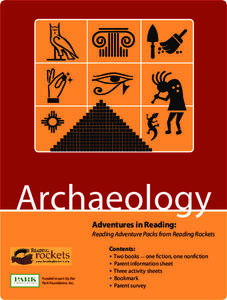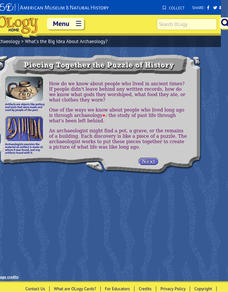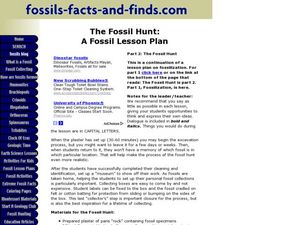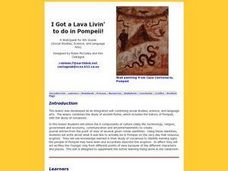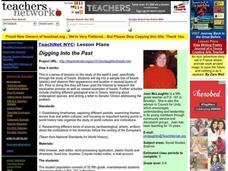PBS
Reading Adventure Pack: Archaeology
Readings of fiction and nonfiction texts followed by a series of activities put scholars in an archaeologist's shoes. Learners read two texts, Archaeologists Dig for Clues by Kate Duke and The Shipwrecked Sailor: An Egyptian Tale with...
American Museum of Natural History
What's the Big Idea About Archeology
The American Museum of Natural History offers a website sure to engage young anthropologists. Learners can dig into a site that offers an explanation of the field of archaeology, the kinds of questions archaeologists ask that launch...
Channel Islands Film
Arlington Springs Man: Lesson Plan 3
Imagine being part of a team of scientists that discover the oldest human remains in North America. Imagine being part of the crew that documents this discovery. Class members get a change to be part of such an exciting adventure in a...
Curated OER
Layer Cake Archaeology
Excavating cake? Why not! Kids spoon into some layers and artifacts during this tasty hands-on activity. The cake, a simulated archaeological dig, is the object of observation and discussion.
Curated OER
Transparent Shoebox Dig
Take this simulated archaeological dig one layer at a time with your young pupils to encourage observation, critical thinking, and careful attention. Using a transparent box full of layers of sand and artifacts, pupils examine the...
Curated OER
Dinosaurs In Argentina
Students study the fossils in Argentina and why it is a good place to find them. In this dinosaurs instructional activity students learn about the recent dinosaur excavations.
Curated OER
What did I find?
Students excavate an artifact. In this archaeology lesson, students get a bucket filled with dirt and a broken up artifact. They work in groups to take it out and to find what its purpose was.
Curated OER
The Fossil Hunt
Students recall prior knowledge of the process of fossilization. In this fossils lesson, students first create and at a later date, recover fossils. Students understand the painstaking process of recovering a fossil. Students recover and...
Curated OER
Archaeology: Digging in the Classroom
Students explore how an archaeologist works and makes discoveries. In this archaeology lesson, students participate in a simulation in which they excavate broken pottery. Students use measurement, geometry, and observation skills during...
Curated OER
Basics of Archaeology
Students identify what and how to complete an Archaeological excavation is conducted. They identify the transition from one layer to the next more easily if the colors of the layers are different. When creating a dig, the teacher...
Curated OER
Mapping and Excavating a Jello Mold
Students simulate how archaeologists excavate sites by "searching" their own site in the form of a Jello mold. They use a grid to map the objects in the Jello mold as well as looking at three layers of Jello to understand stratigraphy...
Curated OER
I Got a Lava Livin' to Do in Pompeii
Scholars imagine themselves as citizens of Pompeii in 79 AD. First they are assigned a job (or place in society like a child or slave). Then they record their daily activities for the weeks leading up to the eruption of Mt. Vesuvius in...
Curated OER
Back From the Future
Students pose as archaeologists, famous for their scholarly excavations, writing, and lectures about ancient cultures and are invited back to the 20thy century from the year 3000 to explore an archaeological sit, their classroom.
Curated OER
Mycenaean Trade in the Mediterranean
Students role play as scientists working for the Institute of Nautical Archaeology, Bodrum, Turkey. They locate Bodrum on a map and study the Mycenaean trade around the Mediterranean Sea. They discover what goods were traded during the...
Curated OER
Archaeological Soils
Students evaluate how archaeologists use soils to interpret sites and determine components of a soil sample.
Curated OER
Digging Into the Past
Students participate in an excavation simulation, and explore the ruins of Sardis. They ponder which clues scientists use to determine if artifacts found in the excavation are of Persian, Greek, Roman, Byzantine, or Lydian origin.
Curated OER
Lesson Design Archaeology
Learners participate in their own excavation and measure and record as they go. In this archaeology lesson students divide into groups and solve the mystery of what they uncovered in their dig box.
Curated OER
What's in the Soil?
Second graders create stratified soil levels using pictures. In this earth science lesson, 2nd graders identify "artifacts" from 3 historic eras and divide them into 3 soil levels. Then they draw their own multi-level soil profile and...
Curated OER
Digging Into the Past
Fifth graders study fossils and how they are charted. In this fossil lesson plan, 5th graders research the excavation process of discovering fossils, and view fossils. They then do a hands on activity that involves plastic fossils that...
Curated OER
General Description of Site
In this earth science worksheet, students identify what a site matrix is and that is composed of a sandstone mixture. They excavate each quadrant and write detailed journal entries. Students also complete a site map that illustrates...
Curated OER
Old Warriors Face New Battle
In this history worksheet, learners read an excerpt that describes the terracotta warriors and what they faced. They respond to four short answer questions related to the excerpt and photo. Students identify what the archaeologists...
Curated OER
Dell House Dig
Students demonstrate basic procedures for archeological excavations. They participate in an archaeological dig exploration off of Blackhawk Island in the Wisconsin River where the Dell House once stood.
Curated OER
Mapping and Excavating a Jello Mold
Fifth graders, in groups, map the three layers of different colored jello layers in molds and note the placement of fruit in them. On the grid paper they draw each grape, raisin, or other object and carefully remove each layer. After...
Curated OER
Shells on the Mountain Top?
Students work in groups to remove fossils from sediments, classifying as many organisms and parts of organisms as possible into major groups. They study the data from each formation and make conclusions about the types of organisms and...


